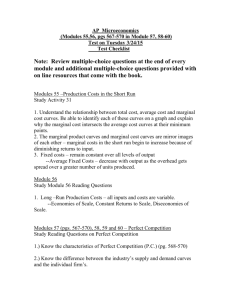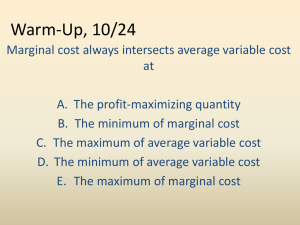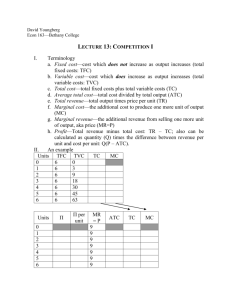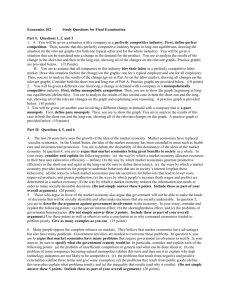Chapter No. 6
advertisement
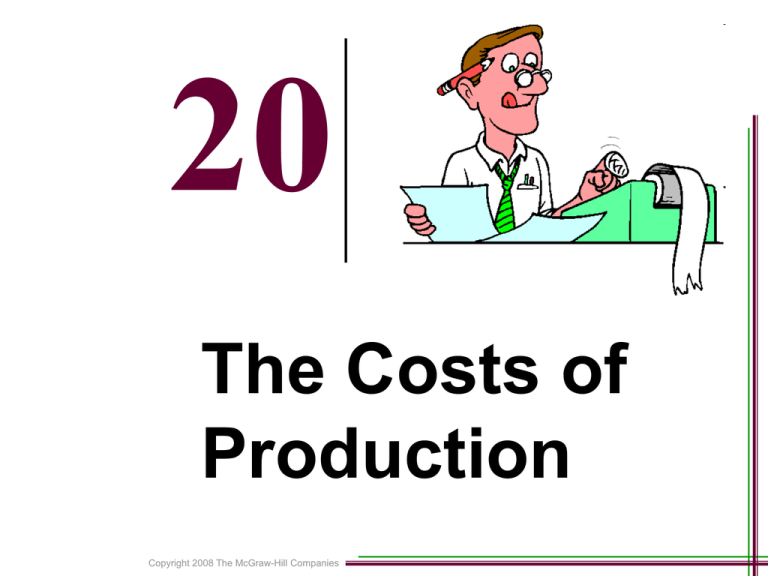
20 The Costs of Production 20-1 Copyright 2008 The McGraw-Hill Companies Chapter Objectives • Why Do Economic Costs Include Both Explicit Costs and Implicit Costs • How Does the Law of Diminishing Returns Relate to a Firm’s Short-Run Production Costs • Learn the Distinctions Between Fixed and Variable Costs and Among Total, Average, and Marginal Costs • Learn the Link Between a Firm’s Size and Its Average Costs in the Long Run 20-2 Copyright 2008 The McGraw-Hill Companies Economic costs • are the payments a firm must make, or incomes it must provide, to resource suppliers to attract those resources away from their best alternative production opportunities. • Payments may be explicit or implicit. Explicit costs • are payments to non-owners - of the firm - for resources they supply. Implicit costs • are the money payments the self-employed resources could have earned in their best alternative employments. 20-3 Copyright 2008 The McGraw-Hill Companies Example • Ali runs a small firm. He hires one helper at $12,000 per year, pays annual rent of $5,000 for his shop, and spends $20,000 per year on materials. He has $40,000 of his own funds invested in equipments that could earn him $4,000 per year if alternatively invested. He has been offered $15,000 per year to work as a manager for a competitor. He also estimates his entrepreneurial talents are worth $3,000 per year. Total annual revenue from his firm sales is $72,000. Calculate accounting profits and economic profits for Ali. • Explicit costs: $37,000 (= $12,000 for the helper + $5,000 of rent + $20,000 of materials). • Implicit costs: $22,000 (= $4,000 of forgone interest + $15,000 of forgone salary + $3,000 of entrepreneurship). Accounting profit = $35,000 (= $72,000 of revenue $37,000 of explicit costs); • Economic profit = $13,000 (= $72,000 - $37,000 of explicit costs - $22,000 of implicit costs). 20-4 Copyright 2008 The McGraw-Hill Companies Normal profits • are considered an implicit cost because they are the minimum payments required to keep the owner’s entrepreneurial abilities self-employed. This is $3,000 in the example. Accounting profits • Are the total revenue less explicit costs. Economic or pure profits • are total revenue less all costs (explicit and implicit including a normal profit). 20-5 Copyright 2008 The McGraw-Hill Companies Profits Compared Economic Profit Versus Accounting Profits 20-6 Economic Profit Implicit Costs (Including a Normal Profit) Explicit Costs Copyright 2008 The McGraw-Hill Companies Accounting Total Revenue Economic (Opportunity) Costs Economics Accounting Profit Accounting Costs (Explicit Costs Only) The short run • is the time period that is too brief for a firm to alter its plant capacity. The plant size is fixed in the short run. Short-run costs, are the wages, raw materials, etc., used for production in a fixed plant. The long run • is a period of time long enough for a firm to change the quantities of all resources employed, including the plant size. Long-run costs are all costs, including the cost of varying the size of the production plant. Short-Run Production Relationships Short-run production • reflects the law of diminishing returns that states that “as successive units of a variable resource are added to a fixed resource, beyond some point the product attributable to each additional resource unit (MP) will decline”. 20-7 Copyright 2008 The McGraw-Hill Companies Total product (TP) • is the total quantity, or total output, of a particular good produced. Marginal product (MP) • is the change in total output resulting from each additional input of labor. Average product (AP) • is the total product divided by the total number of workers. • The following figure illustrates the law of diminishing returns graphically and shows the relationship between marginal, average, and total product concepts. 20-8 Copyright 2008 The McGraw-Hill Companies Law of Diminishing Returns O 20.1 (1) Units of the (2) Variable Resource Total Product (Labor) (TP) 0 0 ] 10 1 ] 25 2 ] 45 3 ] 60 4 ] 70 5 ] 75 6 ] 75 7 ] 70 8 20-9 Copyright 2008 The McGraw-Hill Companies (3) Marginal Product (MP), Change in (2)/ Change in (1) 10 15 20 15 10 5 0 -5 (3) Average Product (AP), (2)/(1) Increasing 10.00 Marginal 12.50 Returns 15.00 Diminishing 15.00 Marginal 14.00 Returns 12.50 Negative 10.71 Marginal Returns 8.75 Total Product, TP Law of Diminishing Returns • Graphical Portrayal 30 20 10 Marginal Product, MP 0 20-10 TP 1 2 3 Increasing Marginal 20 Returns 4 5 6 7 9 Negative Marginal Returns Diminishing Marginal Returns 10 Copyright 2008 The McGraw-Hill Companies 8 AP 1 2 3 4 5 6 7 8 9 MP O 20.2 Note: • When marginal product begins to diminish, the rate of increase in total product stops accelerating and grows at a diminishing rate. • The average product declines at the point at which the marginal product slips below average product. • Total product declines when the marginal product becomes negative. • The law of diminishing returns assumes all units of variable inputs - workers in this case - are of equal quality. Marginal product diminishes not because successive workers are inferior but because more workers are being used relative to the amount of plant and equipment available. 20-11 Copyright 2008 The McGraw-Hill Companies Short Run Production Costs • Fixed, variable and total costs are the short-run classifications of costs; Total fixed costs • Are those costs whose total does not vary with changes in short-run output. Total variable costs • Are those costs that change with the level of output. They include payment for materials, fuel, power, transportation services, most labor, and similar costs. Total cost • Is the sum of total fixed and total variable costs at each level of output (see Figure 20.3). 20-12 Copyright 2008 The McGraw-Hill Companies Short-Run Production Costs Total Cost, Fixed and Variable Costs $1100 TC 1000 900 TVC 800 Costs 700 600 Fixed Cost 500 400 Total Cost 300 Variable Cost 200 100 TFC 0 20-13 1 Copyright 2008 The McGraw-Hill Companies 2 3 4 5 6 7 8 9 10 Q Per unit or average costs • There are three types of average or per unit costs: Average fixed cost: is the total fixed cost divided by the level of output (TFC/Q). It will decline as output rises. Average variable cost: is the total variable cost divided by the level of output (AVC = TVC/Q). Average total cost: is the total cost divided by the level of output (ATC = TC/Q), sometimes called unit cost or per unit cost. Note that ATC also equals AFC + AVC. Marginal cost • Is the additional cost of producing one more unit of output (MC = change in TC/change in Q). 20-14 Copyright 2008 The McGraw-Hill Companies • Marginal cost can also be calculated as MC = change in TVC/change in Q. • Marginal decisions are very important in determining profit levels. Marginal revenue and marginal cost are compared. • Marginal cost is a reflection of marginal product and diminishing returns. When diminishing returns begin, the marginal cost will begin its rise. • The marginal cost is related to AVC and ATC. These average costs will fall as long as the marginal cost is less than either average cost. As soon as the marginal cost rises above the average, the average will begin to rise. • Cost curves will shift if the resource prices change or if technology or efficiency change. 20-15 Copyright 2008 The McGraw-Hill Companies Short-Run Production Costs Average and Marginal Costs $200 MC Costs 150 AFC ATC AVC 100 50 AVC AFC 0 1 2 3 4 5 6 7 8 9 10 Q G 20.1 20-16 Copyright 2008 The McGraw-Hill Companies Average Product and Marginal Product Short-Run Production Costs Production Curves Cost Curves AP MP Quantity of Labor MC Cost (Dollars) AVC Quantity of Output 20-17 Copyright 2008 The McGraw-Hill Companies • Long-Run Production Costs • In the long-run, all production costs are variable, i.e., longrun costs reflect changes in plant size and industry size can be changed (expand or contract). • The following figure illustrates different short-run cost curves for five different plant sizes. • The long-run ATC curve shows the least per unit cost at which any output can be produced after the firm has had time to make all appropriate adjustments in its plant size. 20-18 Copyright 2008 The McGraw-Hill Companies Long-Run Production Costs Average Total Costs Long-Run ATC Curve ATC-1 ATC-5 ATC-2 ATC-3 ATC-4 Output Any Number of Short-Run Optimum Size Cost Curves Can Be Constructed 20-19 Copyright 2008 The McGraw-Hill Companies Long-Run Production Costs Average Total Costs Long-Run ATC Curve ATC-1 ATC-5 ATC-2 ATC-3 ATC-4 Long-Run ATC Output The Long-Run ATC Curve Just “Envelopes” the Short Run ATCs 20-20 Copyright 2008 The McGraw-Hill Companies Economies of Scale • Economies or diseconomies of scale exist in the long run. Economies of scale or economies of mass production explain the downward sloping part of the long-run ATC curve, i.e. as plant size increases, long-run ATC decrease. Reasons for economies of scale • Labor and managerial specialization is one reason for this. • Ability to purchase and use more efficient capital goods also may explain economies of scale. • Other factors may also be involved, such as design, development, or other “start up” costs such as advertising and “learning by doing.” 20-21 Copyright 2008 The McGraw-Hill Companies Diseconomies of scale • may occur if a firm becomes too large as illustrated by the rising part of the long-run ATC curve. For example, if a 10 percent increase in all resources result in a 5 percent increase in output, ATC will increase. Some reasons for this include distant management, worker alienation, and problems with communication and coordination. Constant returns to scale • will occur when ATC is constant over a variety of plant sizes. • Both economies of scale and diseconomies of scale can be demonstrated in the real world. Larger corporations at first may successful in lowering costs and realizing economies of scale. To keep from experiencing diseconomies of scale, they may decentralize decision making by utilizing smaller production units. 20-22 Copyright 2008 The McGraw-Hill Companies Long-Run Production Costs Average Total Costs Alternative Long-Run ATC Shapes Constant Returns To Scale Economies Of Scale Diseconomies Of Scale Long-Run ATC q1 q2 Output Long-Run ATC Curve Where Economies Of Scale Exist 20-23 Copyright 2008 The McGraw-Hill Companies Long-Run Production Costs Average Total Costs Alternative Long-Run ATC Shapes Economies Of Scale Diseconomies Of Scale Long-Run ATC Output Long-Run ATC Curve Where Costs Are Lowest Only When Large Numbers Are Participating 20-24 Copyright 2008 The McGraw-Hill Companies Long-Run Production Costs Average Total Costs Alternative Long-Run ATC Shapes Economies Of Scale Diseconomies Of Scale Long-Run ATC Output Long-Run ATC Curve Where Economies Of Scale Exist, are Exhausted Quickly, And Turn Back Up Substantially 20-25 Copyright 2008 The McGraw-Hill Companies Minimum efficient scale • The concept of minimum efficient scale defines the smallest level of output at which a firm can minimize its average costs in the long run. • The firms in some industries realize this at a small plant size: apparel, food processing, furniture, wood products, snowboarding, and small-appliance industries are examples. • In other industries, in order to take full advantage of economies of scale, firms must produce with very large facilities that allow the firms to spread costs over an extended range of output. Examples would be: automobiles, aluminum, steel, and other heavy industries. This pattern also is found in several new information technology industries. 20-26 Copyright 2008 The McGraw-Hill Companies Applications and illustrations • The terrorist attacks on September 11, 2001, have led to rising insurance and security costs. Some of these costs are fixed (insurance premiums and security cameras), while others are variable (number of security guards). Both have resulted in an upward shift of the ATC curves. • Recently there have been a number of start-up firms that have been able to take advantage of economies of scale by spreading product development costs and advertising costs over larger and larger units of output and by using greater specialization of labor, management, and capital. • In 1996 Verson (a firm located in Chicago) introduced a stamping machine the size of a house weighing as much as 12 locomotives. This $30 million machine enables automakers to produce in 5 minutes what used to take 8 hours to produce. 20-27 Copyright 2008 The McGraw-Hill Companies • Newspapers can be produced for a low cost and thus sold for a low price because publishers are able to spread the cost of the printing equipment over an extremely large number of units each day. • The aircraft assembly and ready-mixed concrete industries provide extreme examples of differing MESs. Economies of scale are extensive in manufacturing airplanes, especially large commercial aircraft. As a result, there are only two firms in the world (Boeing and Airbus) that manufacture large commercial aircraft. The concrete industry exhausts its economies of scale rapidly, resulting in thousands of firms in that industry. 20-28 Copyright 2008 The McGraw-Hill Companies LAST WORD: Don’t Cry over Sunk Costs • Sunk costs are irrelevant in decision-making. • The old saying “Don’t cry over spilt milk” sends the message that if there is nothing you can do about it, forget about it. • A sunken ship on the ocean floor is lost, it cannot be recovered. It is what economists’ call a “sunk cost.” • Economic analysis says that you should not take actions for which marginal cost exceeds marginal benefit. • Suppose you have purchased an expensive ticket to a football game and you are sick the day of the game; the price of the ticket should not affect your decision to attend. • In making a new decision, you should ignore all costs that are not affected by the decision. • A prior bad decision should not dictate a second decision for which the marginal benefit is less than marginal cost. 20-29 Copyright 2008 The McGraw-Hill Companies • Suppose a firm spends a million dollars on R&D only to discover that the product sells very poorly. The loss cannot be recovered by losing still more money in continued production. • If a cost has been incurred and cannot be partly or fully recouped by some other choice, a rational consumer or firm should ignore it. • Sunk costs are irrelevant! Don’t cry over spilt milk or sunk costs! 20-30 Copyright 2008 The McGraw-Hill Companies Key Terms • economic (opportunity) cost • explicit costs • implicit costs • normal profit • economic profit • short run • long run • total product (TP) • marginal product (MP) • average product (AP) • law of diminishing returns • fixed costs 20-31 Copyright 2008 The McGraw-Hill Companies • • • • • • • • • • variable costs total cost average fixed cost (AFC) average variable cost (AVC) average total cost (ATC) marginal cost (MC) economies of scale diseconomies of scale constant returns to scale minimum efficient scale (MES) • natural monopoly Next Chapter Preview… Pure Competition 20-32 Copyright 2008 The McGraw-Hill Companies



